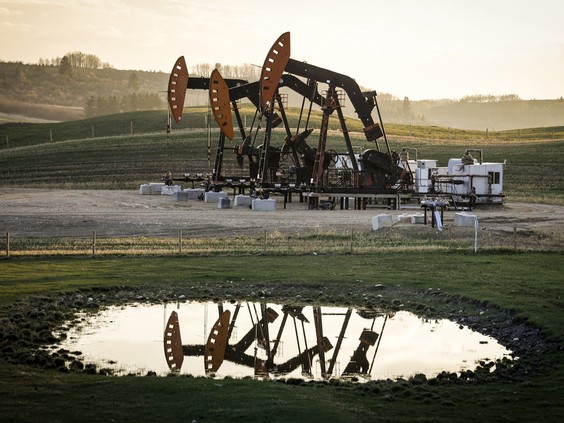"Drill, Baby, Drill!"
"We were running out of Tier 1 inventory; everybody's running out of Tier 1 inventory.""The best inventory is going to be run out of Pioneer by 2028, Tier 2 by '32, so people don't talk about the fact that we're running out of inventory."Scott Sheffield, founder, former U.S. Permian fracking giant Pioneer Natural Resources Co."It's a very touchy topic down here, that the [U.S.] Permian [Basin] is this infinite resource that will always keep going.""But the Permian is no longer in its first inning.""[U.S.] oil and gas companies have some pretty deep pockets and they should be turning back to Canada, given that they don't have unlimited running room here.""We're growing like mad in the Montney [Alberta oilsands]. The major natural gas plays in the U.S. are actually declining versus the Montney [shale] that is actually growing."Mike Verney, executive vice-president, McDaniel & Associates Consultants Ltd."We're Texas-sized as far as gas goes; we've got some big numbers.""Long term, we are the best place to invest in the world because as other resources dry up, Alberta is not going anywhere for a long time."Alberta Energy Minister Brian Jean
| It would cost hundreds of millions of dollars to retool U.S. refineries to handle domestically produced oil. But stopping U.S. exports would also leave Canadian crude with few market options. (Todd Korol/Reuters) |
U.S.
President Donald Trump is on public record, sneering that Canada hasn't
got anything that his country needs, including energy resources, of
which America has more than sufficient for its needs and more. This, as
part of his explosive trade war, which began with Canada and Mexico when
he first threatened, then imposed across-the-board tariffs on all goods
entering the United States from Canada and Mexico, then extended his
tariff war to China, before finally lassoing the European Union, then
South Korea and Japan.
So
how's the United States doing in providing energy resources for itself
beyond the present time? American energy executives at the CERAWeek by
S&P Global conference in Houston are now agreeing there has been a
slowdown in oil production in 2025, anticipating a potential peak in
U.S. oil production just around the corner of the near future. This,
despite his calls to "drill, baby, drill".
These
types of dismal prognostics seem misplaced at the conference where
peak oil predictions are fairly unpopular, given its close proximity to
the most prolific oilfield in the United States, the Permian Basin -- a
region spanning parts of West Texas and southwestern New Mexico --
region that is recognized as the primary driver of U.S. oil and gas
production growth latterly.
| American oil refiners are largely equipped to handle heavier crude imported from other countries such as Canada. (Bing Guan/Reuters) |
Permian
output saw a record 6.3 million barrels daily in 2024, accounting for
some half of the U.S. total production in the last year, at the same
time that other shale oil plays plateaued or declined, according to the
U.S. Energy Information Administration (EIA). That preceded symptoms the
Permian may be entering its declining production years with
well-productivity issues being experienced by producers alongside
diminishing production growth.
This
week, the founder of former Permian fracking giant Pioneer Natural
Resources Co. said that one of the main reasons his company sold out to
Exxon Mobile Corp. in 2023 was the very issue made clear -- that it was
running out of top-tier drilling inventory.
Despite
tremendous domestic reserves there is uncertainty about the U.S.
capacity to feed a booming liquefied natural gas (LNG) sector while
tending to growing domestic demands for natural gas-fired electricity
generation driven by energy-voracious data centres, due in part to a
shortage of pipeline capacity.
There
are persistent doubts whether President Trump's willingness to make use
of emergency powers in expediting, permitting and fast-tracking project
reviews, to the delight of the U.S. oil and gas industry, will
translate to a significant production increase required to meet the
demand of an LNG export sector expected to double in size by 2028.
The
issues of geological degradation and capital discipline among producers
have served to alter the American oil and gas sector, and operators no
longer leap with the same alacrity to drill new wells, even when oil
prices are relatively high. American companies and investors searching
out more accessible resources and economic opportunities are beckoned a
couple of thousand kilometres north to the vast Alberta oilsands and
Canada's Montney shale play.
Compared
to a previous Alberta provincial estimate of 24 TCF, new data reveal
that Alberta has proven natural gas reserves of 130 trillion cubic feet
(TCF). The overall figure comes to 144 TCF when probable gas reserves
are added, according to a study commissioned by the Alberta Energy
Regulator, conducted by McDaniel & Associates Consultants. That new
estimate of gas reserves over-doubles Canada's overall total, placing
Canada into the global top 10 with the ninth-most reserves, up from
15th, previously.
As
well, new preliminary estimates confirm that proven oil reserves in
Alberta reached 167 billion barrels, an increase from the last official
estimate of 159 billion; final numbers in coming weeks expected after an
audit has been completed for all basins. Texas' proven reserves in 2023
by comparison, were 20 billion barrels, according to EIA estimates.
 |
Labels: Alberta Oilsands, Canada-U.S. Relations, Steep Tariffs, Texas Diminishing Energy Resources, U.S. President Trump's Trade War
0 Comments:
Post a Comment
<< Home